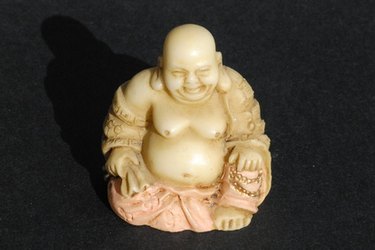Things You'll Need
Air-drying clay
Blunt knife
Cocktail stick
Acrylic or other thick paint
Craft glaze
Paint brush
Brush for glaze

Some Buddha statues are made of wax, wood or stone. However, the aspiring sculptor should use clay, as it is easily moldable and very forgiving. This task will require patience and focus. But if you are good with your hands and have an eye for detail, you will have a striking adornment when you are finished.
Head and Body
Step 1
Cut off half a block of air-drying clay to make a 3-inch-tall Buddha.
Video of the Day
Step 2
Take a third of your block and roll it in your hands. The clay should become soft and pliable. Then roll it into a smooth, bald head.
Step 3
Roll the other two-thirds of your block into a round body shape, again, until it is smooth and pliable.
Step 4
Place the head on top of the body and slowly, with your fingers moving downwards along the base of the head, attach it to the body.
Step 5
Mold the Buddha's chest so it takes on more human characteristics. Give him folds on his tummy and dig out his belly button using the cocktail stick. Mold his pectoral muscles and nipples using your fingers.
Arms and Legs
Step 1
Break off a lump of clay from the remainder of your block to make his arm. It should reach from his shoulder to about halfway across his belly. Twist this into a thick sausage shape. Then gently start working the arm into the shoulder base. Make an elbow bend and place the forearm across his belly. Then repeat this process for his other arm.
Step 2
Place one hand on top of the other to form an oval shape. Then make marks with your knife about halfway down the oval shape to look like fingers. Pinch the clay gently in the middle of each finger to make it look like a finger joint.
Step 3
Take another lump of clay from your remaining piece that is slightly bigger than the amount you took for both arms. Roll the clay in your hands until it is soft. Make it into a ball with a hole in the middle in which to set the Buddha's body. Flatten the edges so it looks more like a doughnut.
Put Buddha Together and Mold His Features
Step 1
Place the Buddha body inside the doughnut shape and secure it by gently molding together the body with the inner part of the doughnut. Make his legs look crossed by raising the two parts of the doughnut on each side of his body up slightly and making a pointy-knee shape by pinching the clay on the raised edges.
Step 2
Make an indent where his legs would meet just under each knee. Then, just under his belly, make the legs look crossed by carving out a small upside down "V" shape with the knife.
Step 3
Pinch a nose in the middle of Buddha's face using your thumb and forefinger. This will also create an indent where his eyes will go.
Step 4
Draw oval shapes for eyes using the cocktail stick, then smooth each one out with your fingers.
Step 5
Pinch out an ear with your thumb and forefinger. Then make an ear-shaped indent using the cocktail stick. Make a line for the mouth with upturned corners, also using the cocktail stick, and then very gently pinch the clay over the top of that line. Finally, smooth around the edges to further define the mouth shape.
Paint and Glaze
Video of the Day
Step 1
Let your Buddha dry for 24 hours. Air-drying clay will need to be completely dry before you paint.
Step 2
Paint the Buddha in colors of your choice, ensuring you get into all the crevices. Leave it to dry again.
Step 3
Paint the Buddha with a craft glaze. Let it dry once more.
Tip
Air-drying clay dries out quickly once it is exposed to the air, so make sure any clay you are not using is wrapped in a plastic bag or container.
Warning
You do not need to put this clay in the oven, as air-drying clay will dry without firing.